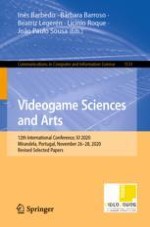2022 | Buch
Videogame Sciences and Arts
12th International Conference, VJ 2020, Mirandela, Portugal, November 26–28, 2020, Revised Selected Papers
herausgegeben von: Inês Barbedo, Bárbara Barroso, Beatriz Legerén, Licínio Roque, João Paulo Sousa
Verlag: Springer International Publishing
Buchreihe : Communications in Computer and Information Science
